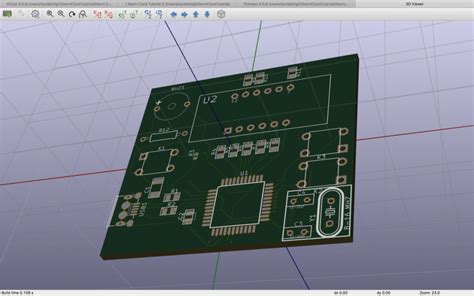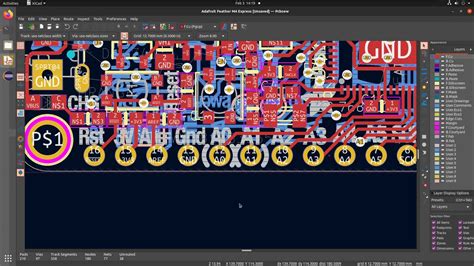Introducing EAGLE and KiCad
Before diving into the comparison, let’s briefly introduce each software:
What is EAGLE?
EAGLE (Easily Applicable Graphical Layout Editor) is a proprietary PCB design software developed by Autodesk. It has been a widely used tool in the electronics industry for over two decades, known for its ease of use and extensive component libraries.
What is KiCad?
KiCad is an open-source PCB design software that has gained significant popularity in recent years. It offers a complete suite of tools for schematic capture, PCB layout, and generation of manufacturing files, all free of cost.
EAGLE vs KiCad: Key Differences
Now, let’s compare EAGLE and KiCad based on several important factors:
User Interface and Ease of Use
One of the first things to consider when choosing a PCB design software is its user interface and learning curve. Here’s how EAGLE and KiCad stack up:
EAGLE’s User Interface
EAGLE features a straightforward and intuitive user interface, making it relatively easy for beginners to get started. The software follows a logical workflow, with separate editors for schematic capture and PCB layout. EAGLE’s interface may feel a bit dated compared to some modern software, but it remains functional and efficient.
KiCad’s User Interface
KiCad’s user interface has undergone significant improvements over the years, becoming more polished and user-friendly. However, it may still have a slightly steeper learning curve compared to EAGLE, especially for those new to PCB design. KiCad’s interface is divided into separate tools for schematic capture (Eeschema), PCB layout (Pcbnew), and other tasks, which can take some getting used to.
| Feature | EAGLE | KiCad |
|---|---|---|
| User Interface | Straightforward and intuitive, but may feel dated | Modern and polished, but may have a steeper learning curve |
| Workflow | Separate editors for schematic capture and PCB layout | Separate tools for schematic capture, PCB layout, and more |
| Learning Curve | Relatively easy for beginners | Slightly steeper, especially for those new to PCB design |
Component Libraries
Access to a wide range of component libraries is crucial for efficient PCB design. Let’s see how EAGLE and KiCad fare in this regard:
EAGLE’s Component Libraries
EAGLE comes with an extensive collection of pre-installed component libraries, covering a broad range of common electronic components. Additionally, Autodesk provides an online library called “EAGLE Content” where users can access and download additional libraries created by the community. Many component manufacturers also provide EAGLE-compatible libraries for their products.
KiCad’s Component Libraries
KiCad also offers a decent selection of default component libraries, though not as comprehensive as EAGLE’s. However, KiCad’s real strength lies in its active community, which contributes to a constantly growing collection of user-created libraries. Websites like SnapEDA and Ultra Librarian provide KiCad-compatible libraries for a wide range of components.
| Feature | EAGLE | KiCad |
|---|---|---|
| Pre-installed Libraries | Extensive collection covering common components | Decent selection, but not as comprehensive as EAGLE |
| Online Libraries | Autodesk’s “EAGLE Content” for community-created libraries | Active community contributing to a growing library collection |
| Manufacturer Libraries | Many manufacturers provide EAGLE-compatible libraries | Websites like SnapEDA and Ultra Librarian offer KiCad libraries |
Schematic Capture
Schematic capture is the process of creating a graphical representation of your circuit’s components and their interconnections. Here’s how EAGLE and KiCad handle this crucial aspect:
EAGLE’s Schematic Editor
EAGLE’s schematic editor is straightforward and easy to use. It offers a good selection of drawing tools, including buses and net classes, to help you create clean and organized schematics. EAGLE also supports hierarchical design, allowing you to break down complex circuits into smaller, more manageable sub-circuits.
KiCad’s Schematic Editor (Eeschema)
KiCad’s schematic editor, called Eeschema, is equally capable and offers a similar set of features. It supports hierarchical design, has a wide range of drawing tools, and allows you to create custom symbol libraries. One notable advantage of KiCad’s schematic editor is its support for SPICE simulation, which enables you to simulate and analyze your circuits directly within the software.
| Feature | EAGLE | KiCad (Eeschema) |
|---|---|---|
| Drawing Tools | Good selection, including buses and net classes | Wide range of drawing tools |
| Hierarchical Design | Supported | Supported |
| Custom Symbol Libraries | Limited support | Supported |
| SPICE Simulation | Not available | Supported, allowing circuit simulation and analysis within KiCad |
PCB Layout
Once your schematic is complete, it’s time to move on to PCB layout, where you’ll arrange components and route traces on your board. Let’s compare EAGLE and KiCad in this regard:
EAGLE’s PCB Layout Editor
EAGLE’s PCB layout editor is robust and offers a wide range of features for designing complex boards. It supports multi-sheet designs, allowing you to work on large projects with ease. EAGLE also offers a variety of routing tools, including autorouting and differential pair routing, to help you create efficient and error-free layouts.
KiCad’s PCB Layout Editor (Pcbnew)
KiCad’s PCB layout editor, called Pcbnew, is equally powerful and offers a similar set of features. It supports multi-sheet designs, has a wide range of routing tools, and offers a 3D viewer for visualizing your board. One advantage of KiCad’s PCB layout editor is its support for scripting and automation, which can significantly speed up your workflow.
| Feature | EAGLE | KiCad (Pcbnew) |
|---|---|---|
| Multi-sheet Designs | Supported | Supported |
| Routing Tools | Wide range, including autorouting and differential pair routing | Wide range of routing tools |
| 3D Viewer | Available | Supported |
| Scripting and Automation | Limited support | Supported, enabling workflow automation |
Manufacturing Output
Once your PCB design is complete, you’ll need to generate manufacturing files to send to your PCB fabrication house. Both EAGLE and KiCad offer comprehensive options for generating these files:
EAGLE’s Manufacturing Output
EAGLE can generate a wide range of manufacturing files, including Gerber files, drill files, and pick-and-place files. It also supports the generation of 3D models in various formats, which can be useful for visualization and enclosure design.
KiCad’s Manufacturing Output
KiCad also supports the generation of all the necessary manufacturing files, such as Gerber files, drill files, and pick-and-place files. Additionally, KiCad offers a built-in Gerber viewer, allowing you to inspect your manufacturing files before sending them out for fabrication.
| Feature | EAGLE | KiCad |
|---|---|---|
| Gerber Files | Supported | Supported |
| Drill Files | Supported | Supported |
| Pick-and-Place Files | Supported | Supported |
| 3D Model Export | Supported in various formats | Supported |
| Gerber Viewer | Not available | Built-in Gerber viewer for file inspection |
Community and Support
When choosing a PCB design software, it’s important to consider the community and support available. Here’s how EAGLE and KiCad compare:
EAGLE’s Community and Support
EAGLE has a large and active community of users, with numerous online forums, tutorials, and resources available. Autodesk also offers official support for EAGLE, including documentation, tutorials, and a knowledge base. However, being a proprietary software, EAGLE’s development is controlled by Autodesk, and users have limited influence on the software’s future direction.
KiCad’s Community and Support
KiCad, being open-source, has a vibrant and engaged community of developers and users. There are numerous online forums, tutorials, and resources created by the community, and users can directly contribute to the software’s development. However, being a community-driven project, KiCad may lack the level of official support and documentation that a proprietary software like EAGLE offers.
| Feature | EAGLE | KiCad |
|---|---|---|
| Community | Large and active user community | Vibrant and engaged community of developers and users |
| Official Support | Offered by Autodesk, including documentation and tutorials | Limited official support, mostly community-driven |
| User Influence | Limited, as development is controlled by Autodesk | Users can directly contribute to the software’s development |

FAQ
- Is EAGLE or KiCad better for beginners?
-
EAGLE may be slightly easier for beginners due to its straightforward interface and extensive pre-installed libraries. However, KiCad’s community-driven nature and open-source philosophy make it an attractive choice for those willing to invest time in learning.
-
Can I use EAGLE or KiCad for commercial projects?
-
Yes, both EAGLE and KiCad can be used for commercial projects. However, EAGLE requires a paid license for commercial use, while KiCad is free and open-source, making it an attractive option for small businesses and startups.
-
Which software has better documentation and learning resources?
-
EAGLE, being a proprietary software, has more official documentation and learning resources provided by Autodesk. KiCad, on the other hand, relies more on community-created resources, which can be extensive but may lack the consistency of official documentation.
-
Can I import EAGLE designs into KiCad or vice versa?
-
While there is no direct way to import EAGLE designs into KiCad or vice versa, there are some third-party tools and scripts available that can help with the conversion process. However, these tools may not always produce perfect results, and some manual cleanup may be required.
-
Which software is more suitable for complex, high-density PCB designs?
- Both EAGLE and KiCad are capable of handling complex, high-density PCB designs. However, KiCad’s scripting and automation capabilities may give it an edge when it comes to managing large and intricate projects.

Conclusion
In the end, the choice between EAGLE and KiCad depends on your specific needs, preferences, and budget. EAGLE offers a more polished and intuitive interface, extensive pre-installed libraries, and official support from Autodesk. On the other hand, KiCad is free and open-source, has a vibrant community, and offers powerful features like SPICE simulation and scripting.
If you value ease of use and official support, EAGLE may be the better choice. If you prefer the flexibility and cost-effectiveness of open-source software, KiCad is an excellent option. Ultimately, both EAGLE and KiCad are capable PCB design tools, and the best choice for you will depend on your individual requirements and design philosophy.

